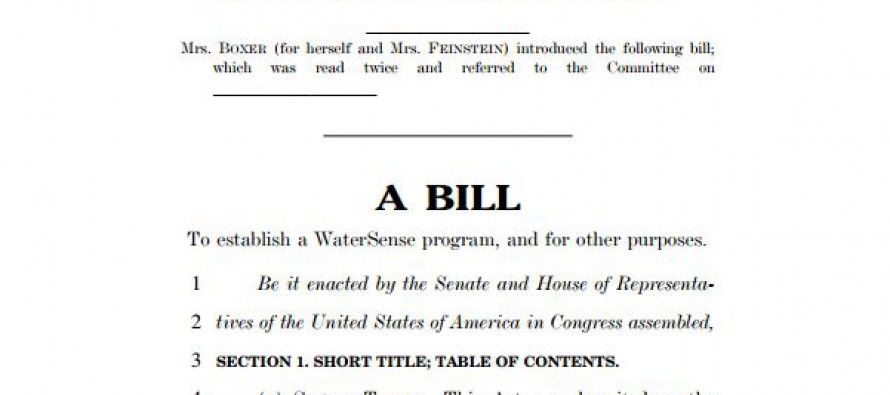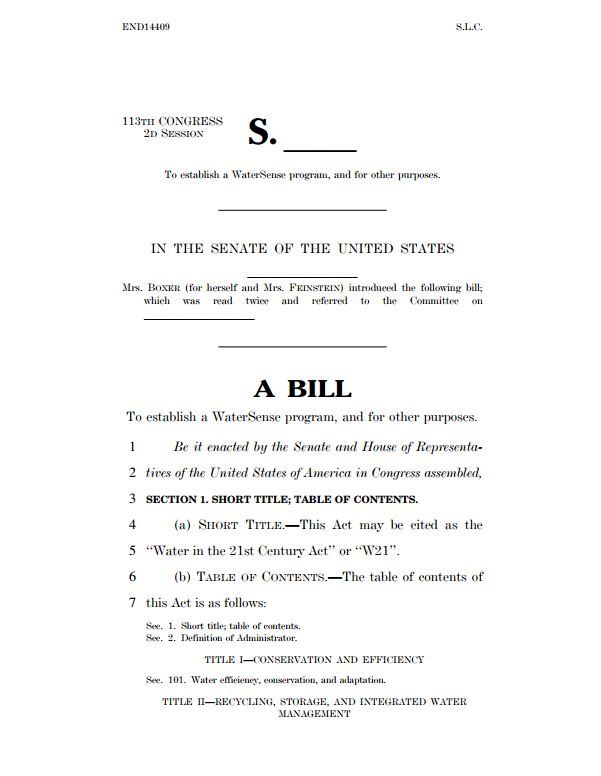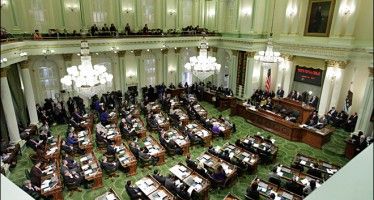Boxer-Feinsten water bill stresses conservation, not supply

 There are two ways to manage water. One way is to capture more water and store it for dry years. The second way is to keep dividing up existing water supplies.
There are two ways to manage water. One way is to capture more water and store it for dry years. The second way is to keep dividing up existing water supplies.
This second way is pushed in a newly proposed bill, the Water in the 21st Century Act, sponsored by California Sens. Dianne Feinstein and Barbara Boxer, both Democrats; and by Reps. Grace Napolitano, D-CA, and Peter DeFazio, D-Ore.
Back on Feb. 11, 2014, Feinstein and Boxer introduced their drought relief bill, Senate Bill 216, “The California Emergency Drought Relief Act of 2014.” The drought relief measures in that bill were already being carried out before that bill was introduced.
Dividing Up Water and Money
Feinstein and Boxer’s new bill, also called W-21, contains $1.1 billion of funding for:
- Title I – Conservation and Efficiency. It would pay 50 percent of the cost to establish a conservation incentive program and offer rebates for installing water efficiency devices up to $700 million over five years. It would target low-income households and first-time home buyers.
- Title II – Recycling, Storage and Integrated Water Management. It would offer $400 million over five years for secured loans and grants for water recycling plants to government agencies, special utility and water districts, Indian Tribes and some corporations; and for groundwater management plans.
- Title III – Innovation Through Research, Data and Technology. It would restore $3 million for the Water Desalination Act and $9 million for the Water Resources Research Act that funds the U.C. Berkeley-based California Institute for Water Resources. Budget hawks have opposed both these acts, calling them “frivolous” and “redundant.”
- Title IV– Drought Preparedness and Resilience. It would provide $3 million to develop drought resilience guidelines for communities, water utilities and drought preparedness for Indian tribes and salmon drought plans
It is not clear what the Boxer-Feinstein bill offers that is not already available at the local level. Many municipal water departments and regional water wholesalers already offer rebate programs for installing water conservation devices.
Wastewater recycling plants can be funded with municipal bonds at the local level and don’t need federal financing. Restoring the Water Research Act and Water Desalination Act would bring back two programs that were cut as part of the plan to cut back federal spending in view of the looming federal debt. And drought plans are already in existence in California.
The problem with more conservation is that California has passed five state water bond propositions since 2000, totaling $18.7 billion. Yet these bonds have funded nothing to withstand the current severe, but predictable, drought.
The Boxer-Feinstein bill just keeps dividing the same water. But as Dan Nelson says, “conservation alone is not enough.” Nelson is the executive director of the San Luis and Delta-Mendota Water Authority, serving 29 water agencies in the Central Valley.
Adding Water
On Aug. 1, Nelson wrote an op-ed in the Sacramento Bee advocating adding new water supplies, rather than divvying up existing supplies more efficiently. San Luis and Mendota are the epicenter of the current water shortage.
He wrote, “Recent studies, including one underway by the Nature Conservancy, indicate that increased surface storage capacity, together with conveyance improvements in the Delta, will provide the greatest benefits for groundwater. These investments will help to both restore stressed groundwater basins and capture abundant surface flows when they are available.”
To Nelson, groundwater management that fails to address adding new water storage will only end up depleting groundwater basins.
Nelson presented data to back up his assertion that the current water shortage is the result of diversions of farm water for fish runs. In 2008 and 2009, over 3 million acre feet of water per year were diverted for Delta smelt and salmon.
Following those water diversions, farmers prepared for an expected future water shortage by investing in about $3 billion in water-efficiency measures.
Nelson cites a study in progress by the Nature Conservancy affirming that increased water storage capacity would “provide the greatest benefits for groundwater.”
It is that increased storage capacity, not the Feinstein-Boxer proposal for more conservation and recycling, that is the key to mitigating future droughts.
Related Articles
Insurance rate rollback sets regulatory precedent
SACRAMENTO – A spat between the California Department of Insurance and the advocacy group Consumer Watchdog over a recent news
Environmentalists face blame for drought
As California’s potent drought inspired soul searching from analysts worried the Golden State can’t grow without water, politicians and officials focused on
CA Senate panel kills whistleblower protection bill for the third time
For the third straight year, the Senate Appropriations Committee killed a bill on Thursday that would have extended whistleblower protections




